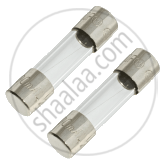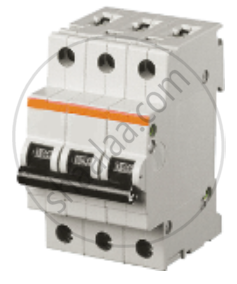Advertisements
Advertisements
Question
Name any two appliances which works on the phenomenon of heating effect of electric current.
Solution
Fuse wire, electric iron, electric bulb, electric cooker, geyser.
APPEARS IN
RELATED QUESTIONS
An electric iron of resistance 20 Ω takes a current of 5 A. Calculate the heat developed in 30 s.
When current is switched ‘on’ in a room heater, it ______.
Give two reasons why nichrome alloy is used for making the heating elements of electrical appliances.
Why does the connecting cord of an electric heater not glow hot while the heating element does?
Which of the following characteristic is not suitable for a fuse wire?
(a) thin and short
(b) thick and short
(c) low melting point
(d) higher resistance than rest of wiring
Give a scientific reason.
For electric power transmission, copper or aluminium wire is used.
Give Scientific reason.
In practice, the unit kWh is used for the measurement of electrical energy, rather than joule.
Identify the figure and give its use.

Identify the figure and give its use.

An electric iron of 1100 W is operated for 2 hrs daily. What will be the electrical consumption expenses for that in the month of April? (The electric company charges Rs 5 per unit of energy).
Rewrite the following statement by selecting the correct option:
1 A = ____________ mA.
The ‘live’ and the ‘neutral’ wires have potential difference of _______.
Which metal is used to make the filament of an electric bulb?
What is overloading?
Write two devices based on the heating effect of electric current.
What does overloading cause?
Explain the application of heating effect of electric current in an electric bulb with a diagram.
Which of the following gases are filled in electric bulbs?
An electric kettle consumes 1 kW of electric power when operated at 220 V. A fuse wire of what rating must be used for it?
Three incandescent bulbs of 100 W each are connected in series in an electric circuit. In another circuit another set of three bulbs of the same wattage are connected in parallel to the same source.
- Will the bulb in the two circuits glow with the same brightness? Justify your answer.
- Now let one bulb in both the circuits get fused. Will the rest of the bulbs continue to glow in each circuit? Give reason.
An electric component used as a safety device is electric circuit is ______.
Can we use the same fuse in a geyser and a television set? Explain.
Your teacher has shown you the following activity.

Activity: The teacher has wound a long insulated piece of wire around an iron nail in the form of a coil. The free ends of the wire are connected to a cell through a switch as shown in Figure 14.3. The current is switched on and some pins are placed near the ends of the nail.
Write down any three questions that come to your mind about this activity
An electric fuse has a body made of ceramic and two points for connecting the fuse wire.
What are the uses of electromagnets?
Copper wire offers very little ______ and does not get heated up quickly.
Fuse is a strip of alloy wire which is made up of lead and tin with a very low ______.
Assertion: A current-carrying wire should be charged.
Reason: The current in a wire is due to the flow of free electrons in a definite direction.
A student boils water in an electric kettle for 20 minutes. Using the same mains supply he wants to reduce the boiling time of water. To do so should he increase or decrease the length of the heating element? Justify your answer.
A fuse is used in an electric circuit to stop high currents flowing through the circuit.
Define the following:
Electrolysis and electrolyte
If 220 V potential difference is applied across an electric bulb, a current of 0.45 A flows in the bulb. What must be the power of the bulb?
1 kWh is equal to ______.
An electric kettle of 2 kW is used for 2h. Calculate the energy consumed in
- kilowatt hour and
- joules.
When a current I flows through a wire of resistance R for time t then the electrical energy produced is given by ______.
